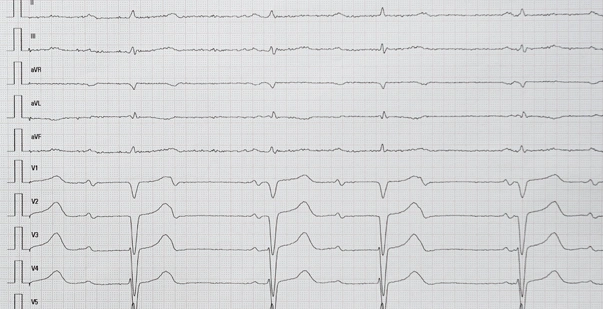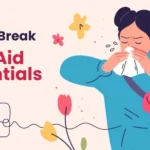Table of content(s)
- What is a Third-Degree Atrioventricular (AV) Block?
- What are the Treatment Options for Third-Degree Heart Block?
- How is Third-Degree AV Block Managed in Clinical Settings?
- What are the Goals of Treating Complete Heart Block?
- What are the Prognosis and Long-Term Outcomes of Third-Degree AV Block?
- When is Pacing Therapy Indicated for Third-Degree AV Block?
- What are the Complications Associated with Temporary Pacing in Third-Degree AV Block?
Third-degree atrioventricular block, also known as complete heart block, requires immediate evaluation and management. Treatment involves permanent pacemaker insertion in chronic cases. Temporary pacing is considered in specific situations, such as high-degree AV block without a stable escape rhythm or life-threatening bradyarrhythmias.
Complications of temporary pacing include lead malposition, dislodgement, and cardiac perforation. The basic goal is to restore the heart rate and prevent complications related to bradycardia. Quick intervention is crucial to prevent adverse outcomes associated with complete heart block. So, let us explore more about this condition and the available treatment options.
Master ACLS Now
Get ACLS certified with confidence
What is a Third-Degree Atrioventricular (AV) Block?
A third-degree atrioventricular (AV) block is also referred to as a complete heart block. It is a serious heart condition where there is a complete loss of communication between the upper chambers (atria) and the lower chambers (ventricles) of the heart. In this condition, the electrical signals generated in the upper chambers are not transmitted to the lower chambers which leads to an independent beating of the atria and ventricles. This results in a slow heart rate and can cause symptoms like dizziness, fainting, and shortness of breath. Here, ACLS (advanced cardiovascular life support) is crucial in managing a complete heart block. It helps healthcare providers promptly recognize and treat life-threatening bradyarrhythmias.
Read more: Everything you need to know about ACLS
What are the Treatment Options for Third-Degree Heart Block?
The treatment for third-degree heart block has various options including:
- Pacemaker:Temporary or permanent pacemaker placement is the standard treatment. A pacemaker helps maintain a healthy heart rate and rhythm.
- Medications:In some cases, medications or synthetic hormones are also used.
- Atropine: Atropine, an anticholinergic drug, is administered intravenously to help restore normal electrical patterns.
- Epinephrine: Epinephrine is a catecholamine hormone, which temporarily supports heart function while awaiting pacemaker implantation.
- Consultation: A cardiologist/electrophysiologist consultation is necessary for the placement of a permanent pacemaker.
The treatment aims to restore a healthy heart rate and rhythm. It ensures adequate pumping of blood.
How is Third-Degree AV Block Managed in Clinical Settings?
Third-degree AV Block is managed in clinical settings through the following approaches:
- Pacemaker Placement: Patients with persistent third-degree AV block typically require permanent cardiac pacing therapy.
- Temporary Pacing: Temporary transvenous pacing may be considered in urgent cases, but it should not be routine and is ideally limited to specific scenarios.
- Medications: Atropine, dopamine, and epinephrine is used as temporary supportive measures, although they may not raise the heart rate efficiently in third-degree AV block.
Master ACLS Now
Get ACLS certified with confidence
What are the Goals of Treating Complete Heart Block?
The goals of treating complete heart block (CHB) include:
- Restoring Healthy Heart Rate and Rhythm: Treatment aims to ensure adequate blood pumping from the heart with each heartbeat.
- Preventing Complications: Immediate management is crucial to prevent adverse outcomes.
- Permanent Pacemaker Placement: Typically required for complete heart block, with 93.75% of non-ischemic heart block patients receiving pacemakers.
- Improving Survival: Survival rates vary, with 12.5% mortality in non-ischemic CHB and 21.4% in ischemic complete heart block.
- Addressing Underlying Causes: Identifying and treating reversible causes like medication-induced complete heart block can lead to positive patient outcomes.
What are the Prognosis and Long-Term Outcomes of Third-Degree AV Block?
The prognosis and long-term outcomes of third-degree AV block are crucial considerations in managing this condition. Let us learn more:
| Factors | Prognosis and Long-Term Outcomes |
| Underlying Cause | The prognosis depends heavily on the etiology (e.g., ischemic heart disease, congenital defects, or infections). |
| Age | Older patients generally have a reduced prognosis due to the presence of comorbidities. |
| Presence of symptoms | Symptomatic patients (e.g., syncope, heart failure) tend to have a decreased prognosis without intervention. |
| Pacemaker Implantation | Improves prognosis and quality of life, reducing mortality and morbidity. |
| Left Ventricular Function | Poor baseline left ventricular function is associated with a negative outcome. |
| Comorbid Conditions | Coexisting conditions such as diabetes, hypertension, and coronary artery disease affect the prognosis adversely. |
| Response to Treatment | Positive response to pacemaker therapy leads to better long-term outcomes. |
| Long-Term Monitoring | Regular follow-up is necessary to manage potential complications and device function. |
When is Pacing Therapy Indicated for Third-Degree AV Block?
Pacing therapy is indicated for third-degree atrioventricular (AV) Block in the following scenarios:
- Patients with symptomatic bradyarrhythmias due to sinus node dysfunction or prolonged sinus pauses benefit from pacemaker placement.
- Patients with Third-Degree AV Block or Type II Second-Degree AV Block should receive pacemakers due to the risk of progression to complete AV block.
- Permanent ventricular pacing for asymptomatic persistent second or 3rd-degree AV Block at the AV node level.
- Pacing therapy for managing third-degree AV Block to prevent adverse outcomes and ensure appropriate heart rhythm regulation.
What are the Complications Associated with Temporary Pacing in Third-Degree AV Block?
Complications of temporary pacing in third-degree atrioventricular (AV) block include:
- Dislodgement of the pacemaker lead.
- Cardiac perforation.
- Short-term complications like lead malposition and cardiac puncture.
- Long-term complications like pacemaker-associated heart failure.
In a study, the overall incidence of temporary pacing in third-degree AV block was 1.6%, with 56% of patients developing Junctional Ectopic Tachycardia (JET). The incidence of complete heart block in acute ST-elevation MI patients was approximately 2.2%, with higher in-hospital mortality in these patients.
Read more: Second-Degree AV Block Type I: Recognizing the Signs and Symptoms
Conclusion
Managing third-degree atrioventricular block, or complete heart block, requires prompt intervention like pacemaker placement. Treatment focuses on restoring a healthy heart rate, preventing complications, and improving survival rates. Complications of temporary pacing include lead malposition and cardiac perforation. Thus, understanding the goals, prognosis, and complications associated with a third-degree AV block is crucial for effective management and positive patient outcomes.







